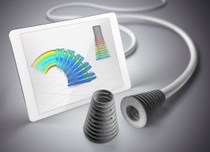Ultrasim®: Simulation now for elastomers
- Simulation for thermoplastic elastomers available now
- Applicable in all stages from initial processing to the final product
- Simulation options include cyclic load situations
BASF expands the application range of its simulation tool Ultrasim®: as of now, the CAE tool also calculates component concepts based on elastomers, especially Elastollan®, BASF’s thermoplastic polyurethane (TPU). The simulation covers the entire process chain from initial processing to the mechanical properties of the final product. Among the special features of the simulation with Ultrasim® are options to simulate both the initial load and cyclic loads of a component. The calculation of component concepts based on elastomers with Ultrasim® is now available.
The property profile of elastomers typically includes stress softening (Mullins effect) under cyclic loading. For reliable simulation results, the consideration of this material behaviour is indispensable. Ultrasim® allows the precise description of stress softening during a cyclic course of loading.
Exact forecast of material behavior
However, the simulation usually starts in the stage of initial processing, delivering an exact forecast of the warpage behavior during injection molding, considering the complex visco-elastic behavior of the material. The simulation with Ultrasim® is now available for several Elastollan® grades. Further grades are currently in the characterization process.
Shorter development times with Ultrasim®
“The simulation tool Ultrasim® provides our customers with quick and reliable information about how BASF materials behave in their planned components, during production as well as at a later stage during service life. Customers who apply Ultrasim® instead of constructing prototypes or carrying out tests can significantly shorten their development times. This simulation support is now also available for Elastollan®”, says Achim Besser, Team Leader Material Modelling in BASF’s Performance Materials division. BASF ist the first material producer offering such wide-ranging simulation services in the TPU sector.
Elastollan® is used in automotive parts such as strain relief sleeves on electric connectors, spring isolators at the axles, folding bellows and end stops for shock absorbers. In interior parts, door handles and gear knobs are produced with TPU. Beyond that, Elastollan® is frequently employed in the consumer goods sector: application examples include ski boots, shoe soles and cable sheathings.
Receive up-to-date news releases from BASF via push notification on your smartphone. Register for our news service at basf.com/pushnewsbasf.com/pushnews.
About BASF’s Performance Materials division
BASF’s Performance Materials division encompasses the entire materials’ know-how of BASF regarding innovative, customized plastics under one roof. Globally active in four major industry sectors – transportation, construction, industrial applications and consumer goods – the division has a strong portfolio of products and services combined with deep understanding of application-oriented system solutions. Key drivers of profitability and growth are our close collaboration with customers and a clear focus on solutions. Strong capabilities in R&D provide the basis to develop innovative products and applications. In 2019, the Performance Materials division achieved global sales of €6.06 bn. More information online: www.plastics.basf.com.
About BASF
At BASF, we create chemistry for a sustainable future. We combine economic success with environmental protection and social responsibility. More than 117,000 employees in the BASF Group work on contributing to the success of our customers in nearly all sectors and almost every country in the world. Our portfolio is organized into six segments: Chemicals, Materials, Industrial Solutions, Surface Technologies, Nutrition & Care and Agricultural Solutions. BASF generated sales of €59 billion in 2019. BASF shares are traded on the stock exchange in Frankfurt (BAS) and as American Depositary Receipts (BASFY) in the U.S. Further information at www.basf.com.
P-20-298


